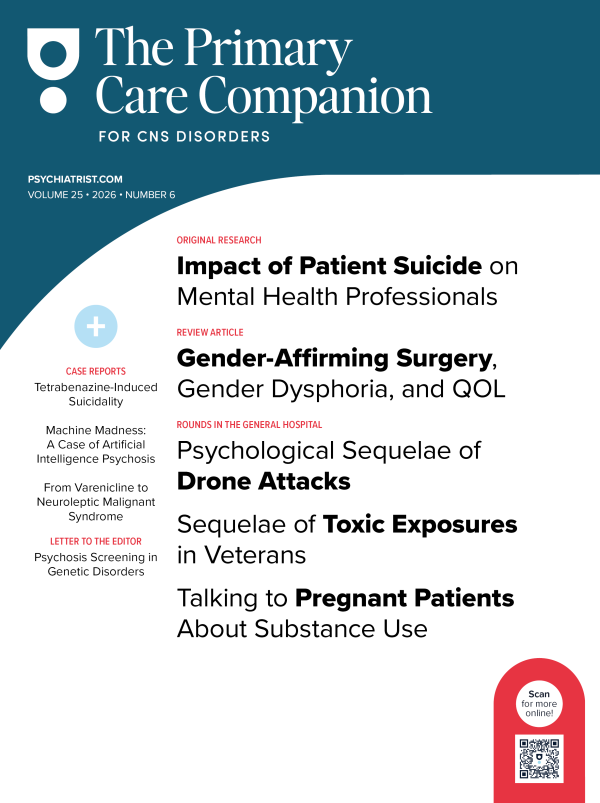To the Editor: According to the Diagnostic and Statistical Manual of Mental Disorders, Fifth Edition,1 factitious disorder is characterized by (1) falsification of physical or psychological signs or symptoms by an individual, with the deception subsequently identified by others; (2) presentation of oneself as ill, impaired, or injured; and (3) absence of an obvious external or tangible reward for the behavior. A number of factitious physical symptoms and syndromes have been described in the extant literature, including but not limited to aortic dissection, cancer, chronic pain, deafness or blindness, hemiplegia, hemoptysis, human immunodeficiency infection, hypoglycemic coma, mydriasis, various neurologic syndromes, osteomyelitis, and quadriplegia.2 However, we were unable to locate a reported factitious case of combined hematemesis and hematochezia. In addition, the creation of signs and symptoms in this case were somewhat unique.
Case report. Ms A was a 37-year-old woman with a past medical history of bipolar disorder, chronic anxiety, polysubstance abuse, chronic hepatitis with cirrhosis, esophageal varices, coagulopathy, and Crohn disease who presented with an acute episode of hematochezia. Hemoglobin level at admission was 11.5 g/dL. An initial esophagogastroduodenoscopy indicated no acute source of bleeding in the oral cavity, esophagus, stomach, or duodenum, yet fresh blood was found in the oropharynx after an episode of vomiting. A subsequent colonoscopy demonstrated shallow linear nonbleeding lesions and edema of the ascending colon that were inconsistent with inflammatory bowel disease. When the rectal bleeding ceased and hemoglobin level stabilized, the patient was discharged.
Five days later, Ms A returned with recurrent rectal bleeding with a hemoglobin level of 11.1 g/dL. Flexible sigmoidoscopy indicated an increased number of linear ulcers in the same region as before, 2 of which were found to be bleeding immediately proximal to the anal verge. Overnight, the patient continued with persistent hematochezia accompanied by a 0.5 g/dL decrease in hemoglobin. A second flexible sigmoidoscopy was ordered. Prior to the procedure, as the patient was being positioned, a small serrated jackknife was found in the bedding just behind the patient. When confronted, the patient initially adamantly denied but then affirmed that the rectal lesions were self-inflicted. The patient explained that she inserted her finger into her rectum with the blade of the knife closely pressed against it, and then carefully made abrasions as deep as possible in her colon. She also confessed that the hematemesis was created through the ingestion of fresh blood from her intravenous line.
A meaningful challenge in the diagnosis of factitious disorder is the extent to which the individual’s reported symptoms are due to choice or psychopathology.3 When factitious disorder is detected, intervention may be compromised by the patient’s unwillingness to cooperate as well as the lack of evidence-based treatment for this disorder. In terms of treatment, psychotherapy is recommended,4 although there is no evidence of efficacy for one treatment over another.5 Dialectical behavior therapy has been proposed.6
Overall, with the development of the Internet, factitious disorders will quite likely become more complex and primary care providers will very likely continue to be challenged. This case report illustrates the fortitude entailed in generating elusive symptoms.
References
1. American Psychiatric Association. Diagnostic and Statistical Manual of Mental Disorders, Fifth Edition. Washington, DC: American Psychiatric Publishing Inc; 2013.
2. Sansone RA, Sansone LA. Medically self-sabotaging behavior and its relationship with borderline personality. Prim Care Rep. 2012;18:37-48.
3. Bass C, Halligan P. Factitious disorders and malingering: challenges for clinical assessment and management. Lancet. 2014;383(9926):1422-1432. PubMed doi:10.1016/S0140-6736(13)62186-8
4. McCullumsmith CB, Ford CV. Simulated illness: the factitious disorders and malingering. Psychiatr Clin North Am. 2011;34(3):621-641. PubMed doi:10.1016/j.psc.2011.05.013
5. Eastwood S, Bisson JI. Management of factitious disorders: a systematic review. Psychother Psychosom. 2008;77(4):209-218. PubMed doi:10.1159/000126072
6. Joest K, Feldmann RE Jr, Bohus M. Dialectical behavior therapy (DBT) in a patient with factitious disorder: therapist’s and patient’s perspective [German]. Psychiatr Prax. 2012;39(3):140-145. PubMed
Author affiliations: Department of Internal Medicine (both authors) and Department of Psychiatry (Dr Sansone), Kettering Medical Center, Kettering; and Departments of Psychiatry and Internal Medicine, Wright State University School of Medicine, Dayton (Dr Sansone), Ohio.
Potential conflicts of interest: None reported.
Funding/support: None reported.
Published online: January 15, 2015.
Prim Care Companion CNS Disord 2015;17(1):doi:10.4088/PCC.14l01693
© Copyright 2015 Physicians Postgraduate Press, Inc.


